A Top End safari with a watery twist
Birds, crocs and barramundi are the main drawcards at Bamurru Plains, a Wild Bush Luxury camp.
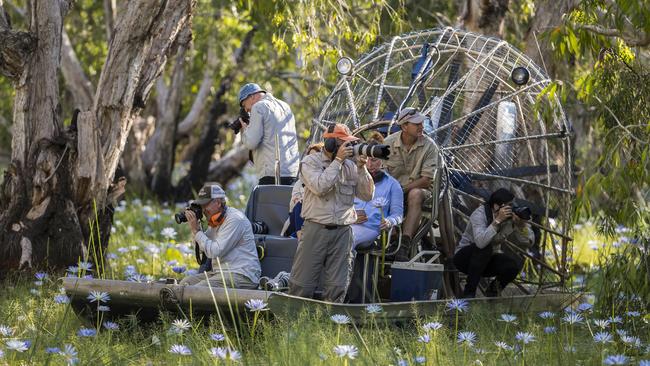
The smooth serenity of skimming across the floodplains belies the fact that I am wearing industrial-strength ear-muffs to dull the roar of the mighty fan propelling our airboat. Sure, the noise and airwaves ruffle the feathers of the abundant birdlife along the way, but that’s all part of the spectacle.
It’s the start of the dry season and we are zooming about a floodplain that’s part of the Northern Territory’s Mary River catchment. As well as 236 species of birds in this region, there are more estuarine crocodiles here than anywhere else in the Territory. Up to 15 lurk in every kilometre of river, which is a sizeable advance on an average of five.
Birds, crocs and barramundi are the main drawcards here at Bamurru Plains, a Wild Bush Luxury camp that operates on (but is separate to) Swim Creek Station, a 300sq km working buffalo station near Kakadu National Park. Buffalo are also very much part of the scenery. It’s calving season when I visit, so there are mums and bubs all around and, truly, buffalo babies are cute.
The fishing season has just ended at the lodge, so the rods and hooks are away and the cameras and binoculars are out, along with the fat little species booklet Bamurru Plains provides for guests to check off the birds, mammals, reptiles, frogs and trees we see and hear on the property.
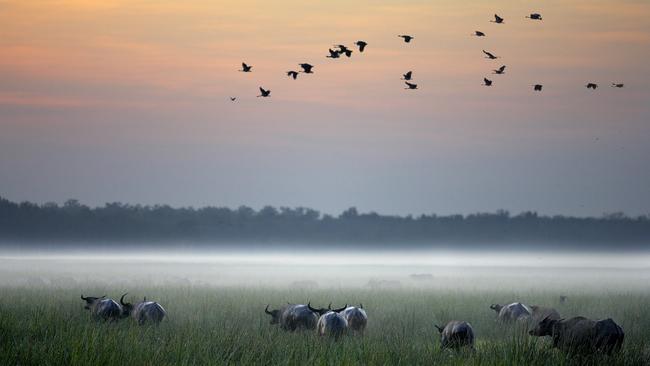
When he picks me up from the airstrip, after a spectacular flight from Darwin over glistening rivers and floodplains, guide Cam Lambie tells me it’s been “bad wet” in the Territory — much lower than average rainfall. Nevertheless, there’s plenty of water for airboats and animals. He started his annual checklist in February; by early May, he had already ticked off 130 species on the property and reckons he’ll hit 200 by the end of the year. “We’ve got such a varied ecosystem here,” says Lambie. “And with so many different habitats, we get a huge array of birds. It’s absolute heaven.”
I’m soon busily checking off my list: great-billed herons, comb-crested jacanas, rainbow bee-eaters, blue-winged kookaburras, pied stilts, striated herons, jabirus, brown falcons, little eagles and sea eagles, azure and sacred kingfishers, green pygmy geese (actually ducks), and the hilariously Dr Seussian-looking Australian bustard, and so many more. About 4000 plumed whistling ducks roost by day on the edge of the floodplain in front of the lodge, sounding like as many boiling kettles as they congregate and like a plane departing when they take flight en masse if a brumby or buffalo wanders through the flock.
As the airboats pass across the floodplain, magpie geese lift from the spike rushes, their bright orange landing gear trailing and making for an ungainly take-off. Once they get air beneath their wings, though, these large birds are just as smooth as their egret mates, which exhibit more jump-jet-style flight trajectories.
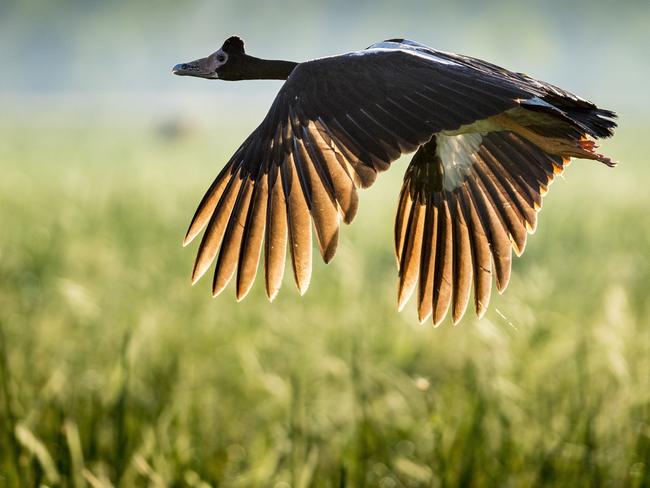
Our guide explains the reason we so often see a trio take flight. It’s a family of one male and two female magpie geese nesting together. Not quite duck and not quite goose, the semi-webbed feet give them the ability to perch in a tree. On the floodplain, Mr Magpie Goose walks in circles to trample the rushes and create the nest and then all join in for the hatching and care of the goslings. It seems to work out pretty well; it’s the tail-end of the breeding season and there are magpie geese everywhere. We see little brown goslings and an abandoned nest with two infertile eggs, which a whistling kite is hitting for lunch.
As you would expect given its remoteness, the lodge is exclusive to guests, who gather in the main building for delicious meals turned out from the small open kitchen. (Hot tip: Sydney chef Christine Manfield is here on reconnaissance when I visit, cooking up one of her celebrated Food Safaris for next year.)
Dinner at the long table turns into a bit of a party each night as new friends share stories. The clientele is usually about half international — Brits, Spaniards, Americans, Canadians and Germans when I’m in the house — which makes for rich conversation, though it never goes late because we all have excursions in the morning. Barking owls sound a pre-emptive reveille about 4.40am, although by the second morning, the dawn chorus is already weaving into my dreams.
I join three airboat excursions in as many days. Safari staff map out excursions for guests around their particular passions and I’m madly in love with the airboat. Travelling across the rushes and then water, unencumbered by seat belts or life jackets, feels like pure freedom. At its deepest, there’s only about a metre of water, so while drowning is not a concern, venturing overboard could turn you into a crocodile snack. Arms in, at all times.
The morning cruise to Kingfisher Cafe, where said birds like to hang out, is a glorious glide through the melaleuca paperbark trees and thousands of blue water lilies stretching on a grand watery parade. Sharp eyes spot crocs and one mighty beast leads us on a merry chase through the trees. He collects a clump of water lilies on his head as he goes, which diminishes his menace a little.
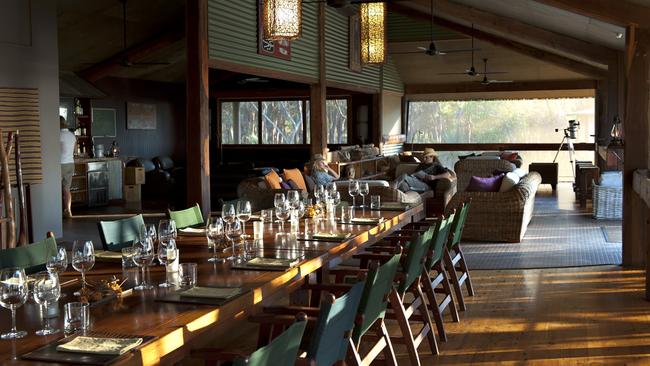
Wildbush Luxury puts a lot into training its guides and it shows in the quality of the commentary and the whole safari experience. On a sunset expedition, stemmed wine glasses and canapes come out to toast the day’s end among the native water lilies. Italian-born guide Anna Teneggi, who made her home in Australia more than a decade ago, demonstrates how the hollow lily stems were favoured as a celery-like snack by indigenous people, who also used them as a snorkel to sneak up on magpie geese (courageous hunting given the waters’ reptilian residents).
An afternoon boating trip from Bamurru Plains’ private pontoon on Sampan Creek with lodge manager Ian “Macca” McEwen brings yet more birds and multiple crocodiles. “In winter it’s nothing for us to see 60 to 80 crocs out here on a two-hour river cruise,” says Macca.
Bamurru’s parent company supports Australian Wildlife Conservancy and Macca gets quite emotional when he describes the ecology of the river system when we reach the mouth of Sampan Creek. “Here in Chambers Bay, we have big alluvial rivers, we have flat systems, we have mud, we have 8m of tidal movement,” he says. “It’s a fast-moving, dynamic and very productive system. The saltwater environment and the floodplains overlap and it’s integral to the healthy marine environment and Australia’s fisheries. It’s so productive because it hasn’t been developed; we haven’t buggered it up. If you reduce the wetlands you have plummeting populations.”
We leave Sampan Creek at dusk for the ride back to the lodge and the Australian bustard we saw appears again, strutting along in front of our slow-moving open-air safari truck. “He does this every day,” says Macca. “He’s got a low brain-to-body ratio.” Like the rest of the abundant wildlife on this remarkable station, the bustard seems to know he’s safe here.
Jane Nicholls was a guest of Wild Bush Luxury and Tourism Northern Territory.
-
More to the Story
Bamurru Plains has understated luxury down pat. Glamping-esque cabins are set on the edge of the floodplain, where buffalo, agile wallabies and brumbies roam. The structure is corrugated iron, but most of the walls are screens. In the day, the animals can’t see in but you can see them and they can hear you. By day, that makes for some startled little wallabies should you happen to sneeze as they nibble on seed pods metres from you. At night, lie there deciphering the sounds: wallaby, buffalo, bird or brumby? (You hope it’s not a cane toad’s thudding hop, but sadly those wreckers made it here about eight years ago, which is bad news for native animals.)
The dawn choristers show up species by species, warming up their morning calls with layers of birdsong. Finally, the light brings the view beyond the screen walls to life. Like a print materialising in a dark room, the shadows of trees show themselves against a pale pink sky. It takes me a while to realise the nasal grunt-grunt-grunt that evokes memories of motel rooms with too-thin walls is not birds but buffalo, moving back from their beds in the bush for another day of feasting on the floodplain.
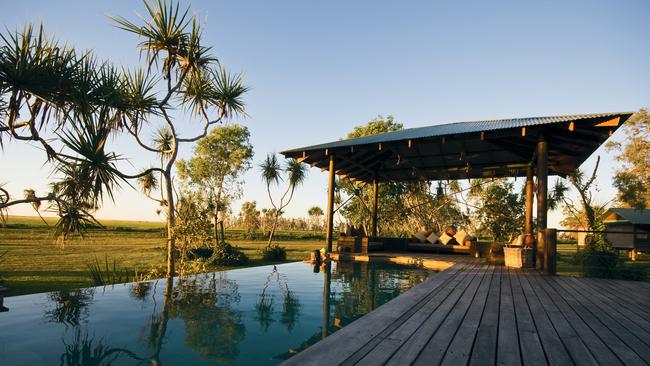
In the room, every comfort has been thought of and then some. There’s no pillow menu, but a choice of six pillows. A generous library of bird and mammal identification books awaits, as do bug sprays, binoculars and an air horn for emergencies (there are no phones, TVs or Wi-Fi). My top-of-the-line Kingfisher Suite has a double shower and vanity, plenty of steaming hot water and full-size Sukin amenities in the enormous bathroom. The main lodge has a lovely deep saltwater pool for cooling off while gazing out to the floodplain and comfy communal areas with more books and safari artefacts. The generous open bar includes excellent wines, spirits and mixers.
-
In the Know
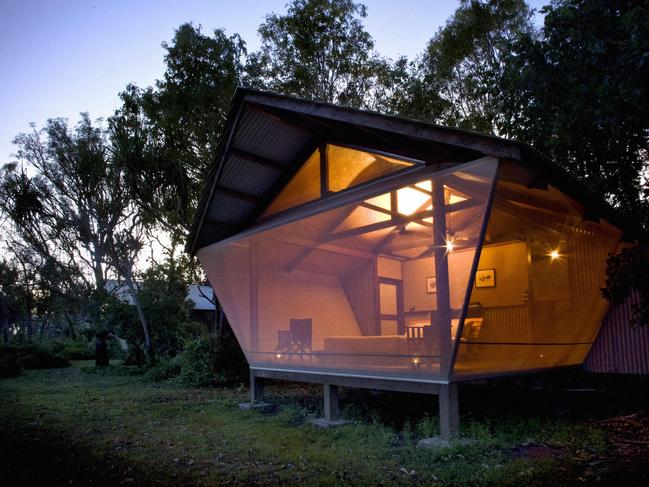
From Darwin, Bamurru Plains is about three hours’ drive (in the dry) or half an hour by charter flight. Accommodation is in nine Safari Bungalows or the larger Kingfisher Suite. The Floodplain Chillout package is from $510 a person a night, twin-share (based on staying three nights in September or October), and includes Safari Bungalow accommodation, all meals and beverages, with guided safaris booked and paid on site. The minimum stay is two nights and some packages include all safari experiences.
Bamurru Plains is closed from November until February, and between late February until the end of April it’s an exclusive fishing lodge. The leisure safari season runs May 1 until October 31. The fifth season of the Northern Territory’s Million Dollar Fish competition kicks off on October 1 until the end of March 2020, with six $1 million tagged barramundi waiting for anglers. Land one and it will pay for many more fishing expeditions.

To join the conversation, please log in. Don't have an account? Register
Join the conversation, you are commenting as Logout